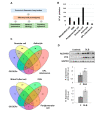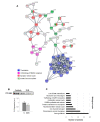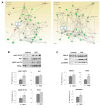Proteomic Characterization of the Olfactory Molecular Imbalance in Dementia with Lewy Bodies
- PMID: 32887355
- PMCID: PMC7503830
- DOI: 10.3390/ijms21176371
Proteomic Characterization of the Olfactory Molecular Imbalance in Dementia with Lewy Bodies
Abstract
Olfactory dysfunction is one of the prodromal symptoms in dementia with Lewy bodies (DLB). However, the molecular pathogenesis associated with decreased smell function remains largely undeciphered. We generated quantitative proteome maps to detect molecular alterations in olfactory bulbs (OB) derived from DLB subjects compared to neurologically intact controls. A total of 3214 olfactory proteins were quantified, and 99 proteins showed significant alterations in DLB cases. Protein interaction networks disrupted in DLB indicated an imbalance in translation and the synaptic vesicle cycle. These alterations were accompanied by alterations in AKT/MAPK/SEK1/p38 MAPK signaling pathways that showed a distinct expression profile across the OB-olfactory tract (OT) axis. Taken together, our data partially reflect the missing links in the biochemical understanding of olfactory dysfunction in DLB.
Keywords: Lewy bodies; dementia; olfaction; olfactory bulb; proteomics.
Conflict of interest statement
The authors declare no conflict of interest.
Figures




Similar articles
-
Tackling the Biological Meaning of the Human Olfactory Bulb Dyshomeostatic Proteome across Neurological Disorders: An Integrative Bioinformatic Approach.Int J Mol Sci. 2021 Oct 20;22(21):11340. doi: 10.3390/ijms222111340. Int J Mol Sci. 2021. PMID: 34768771 Free PMC article.
-
Olfactory function and neuropsychological profile to differentiate dementia with Lewy bodies from Alzheimer's disease in patients with mild cognitive impairment: A 5-year follow-up study.J Neurol Sci. 2015 Aug 15;355(1-2):174-9. doi: 10.1016/j.jns.2015.06.013. Epub 2015 Jun 10. J Neurol Sci. 2015. PMID: 26076880
-
Olfactory bulb proteome dynamics during the progression of sporadic Alzheimer's disease: identification of common and distinct olfactory targets across Alzheimer-related co-pathologies.Oncotarget. 2015 Nov 24;6(37):39437-56. doi: 10.18632/oncotarget.6254. Oncotarget. 2015. PMID: 26517091 Free PMC article.
-
Prodromal dementia with Lewy bodies.Geriatr Gerontol Int. 2015 Jul;15(7):817-26. doi: 10.1111/ggi.12466. Epub 2015 Feb 17. Geriatr Gerontol Int. 2015. PMID: 25690399 Review.
-
The clinical characteristics of dementia with Lewy bodies and a consideration of prodromal diagnosis.Alzheimers Res Ther. 2014 Jul 21;6(4):46. doi: 10.1186/alzrt274. eCollection 2014. Alzheimers Res Ther. 2014. PMID: 25484925 Free PMC article. Review.
Cited by
-
Olfactory Bulb Proteomics Reveals Widespread Proteostatic Disturbances in Mixed Dementia and Guides for Potential Serum Biomarkers to Discriminate Alzheimer Disease and Mixed Dementia Phenotypes.J Pers Med. 2021 Jun 3;11(6):503. doi: 10.3390/jpm11060503. J Pers Med. 2021. PMID: 34204996 Free PMC article.
-
Molecular, Translational and Clinical Research on the Two Most Common Forms of Neurodegenerative Dementia: Alzheimer's Disease and Dementia with Lewy Bodies.Int J Mol Sci. 2023 Apr 28;24(9):7996. doi: 10.3390/ijms24097996. Int J Mol Sci. 2023. PMID: 37175703 Free PMC article.
-
Proteoform Analysis of the Human Olfactory System: A Window into Neurodegenerative Diseases.Proteomes. 2024 Mar 21;12(1):9. doi: 10.3390/proteomes12010009. Proteomes. 2024. PMID: 38535507 Free PMC article. Review.
-
Transcriptional Regulation of the Synaptic Vesicle Protein Synaptogyrin-3 (SYNGR3) Gene: The Effects of NURR1 on Its Expression.Int J Mol Sci. 2022 Mar 26;23(7):3646. doi: 10.3390/ijms23073646. Int J Mol Sci. 2022. PMID: 35409005 Free PMC article.
-
Tackling the Biological Meaning of the Human Olfactory Bulb Dyshomeostatic Proteome across Neurological Disorders: An Integrative Bioinformatic Approach.Int J Mol Sci. 2021 Oct 20;22(21):11340. doi: 10.3390/ijms222111340. Int J Mol Sci. 2021. PMID: 34768771 Free PMC article.
References
-
- McKeith I.G., Dickson D.W., Lowe J., Emre M., O’Brien J.T., Feldman H., Cummings J., Duda J.E., Lippa C., Perry E.K., et al. Diagnosis and management of dementia with Lewy bodies: Third report of the DLB Consortium. Neurology. 2005;65:1863–1872. doi: 10.1212/01.wnl.0000187889.17253.b1. - DOI - PubMed
-
- McKeith I.G., Galasko D., Kosaka K., Perry E.K., Dickson D.W., Hansen L.A., Salmon D.P., Lowe J., Mirra S.S., Byrne E.J., et al. Consensus guidelines for the clinical and pathologic diagnosis of dementia with Lewy bodies (DLB): Report of the consortium on DLB international workshop. Neurology. 1996;47:1113–1124. doi: 10.1212/WNL.47.5.1113. - DOI - PubMed
MeSH terms
Substances
Grants and funding
LinkOut - more resources
Full Text Sources
Medical
Miscellaneous

